From February 13 to 24, 2011, I held my fourth Winter Wonderland Workshop, and took thirteen avid photographers to shoot the Snow Monkeys in Nagano for three days, then joined by one more participant in Hokkaido, we had fourteen participants with us for a further nine days, photographing the amazing wildlife around Eastern Hokkaido.
As I’m going to record and release these episodes as I complete a transcript of a reasonable length for each, I’m not sure how many parts it will be, but I imagine it will turn into three episodes or so. Here’s a look at what we got up to on the first three days in Nagano, photographing the adorable Snow Monkeys.
As I now live further from the start point, I actually spent the night at the Shinagawa Prince Hotel on February 12, along with most of the participants, all of whom had flown in from overseas to take part. A number of us had dinner together that evening, and it was great to start to get acquainted with them all, and also to welcome Graham Morgan, or N.S.W. in the forum and Members’ Galleries, as he arrived during our dinner. This was to be Graham’s third time on the tour, which I always find to be such a huge vote of confidence and proof of the success of these tours, now in our fourth year.
A relatively late start in comparison to many of the days to come, we were up and at breakfast by 6AM and met at 7AM to board our bus out to Nagano. From this year I’d joined forces with a Tour Operator which I’d asked to handle all of the hotel, flight and bus bookings, so that I could concentrate on spending quality time with the group, and to make checking into the hotels and lunch stops smoother. Yukiko from the tour operator would be with us for the entire 12 days of the tour and the group was introduced to her at this point. Yukiko led the group to the bus to get started.
It’s a steady four hour drive out to the Snow Monkeys, but with the early start we were able to start our 30 minute walk out to the Monkey Park shortly after lunch, which we stopped for after leaving the highway. It was a Sunday afternoon, and I had expected a larger crowd, so I was pleased to see that at least some of the group were able to get down beside the hot springs pool in which the Snow Monkeys bath. By the end of the afternoon in fact, there was even a time when I was able to get a photograph of Graham on his own down on the ledge by the pool. You can see the photos that I discuss here embedded into the enhanced Podcast on your iPhone or in iTunes, or go to my blog at martinbaileyphotography.com to see the images and transcript. To jump to this specific episode you should be able to just type mbp.ac/279 into your browsers address bar.
From a workshop perspective, the main point of this first afternoon is to get used to the location, and the subjects. I find that when most people first come to the Snow Monkeys they are at first taken back by how close you actually are to the monkeys. You generally shoot lots of images, many of which are nice photos, but don’t really show any special activity on the Monkey’s part. This is why my first images, and so many other peoples images from the snow monkeys, are just shots of the monkeys sitting in the hot springs. These are certainly worth shooting, and you’d be silly not to tell that story if you are going to the trouble to come out here, but once you have that out of your system, you’ll start to look for something a little more, like a cute expression or action.
Because I personally already have loads of images of the monkeys in the pool, and of course because I wanted as many of my group as possible to get their space down by the pool, and the shots that it allows them. I generally stayed around the top, answering questions when anyone had them, and shooting the odd image myself when I wasn’t working with someone answering their questions.
One image that I posted from this first afternoon was the shot we see here (below) where an adult snow monkey was shaking the snow from its hair, with a youngster looking on. The shot is actually seriously flawed in that I wasn’t quite square on to the monkeys, so although I was lucky to get the face of the monkey shaking its head as it stopped at the end of the movement, so the eyes are almost totally sharp, the young monkey is slightly behind the depth-of-field. This means that although his hand is nice and sharp, his face and eyes are actually slightly soft. If this was a shot of just the youngster, I’d have had to throw it out, but because of the action with the adult, and the angle of the youngsters face, with that inquisitive look, I decided it was worth keeping.
Without really thinking about it, I’d actually squared up a little after this, and have a few more frames with both monkeys in clear focus, but the movement of the adult is not there. Neither is the inquisitive look on the youngsters face, so this is the shot, however flawed. This is the sort of thing that I mean though. Once you have your cute monkeys in the pool shots, you really need to start to watch for something different, and be quick to catch it when it happens.
We had a lot of fun with these monkeys in the snow. Here’s another shot of a few of the group photographing the monkeys on the side of the hill, where I’d just made the last image.
The hotel that we stay at in Nagano is a really nice traditional Japanese hotel or Ryokan. Although there’s often a little too much food to eat everything, the food here is great too, and I had our guide take the following photo of us as we sat down for dinner on the first night.
On the 14th of February, the second day at the snow monkeys, we were due to have a full day, and now the group had gotten their first day becoming accustomed to the location and subjects out of their system. It also gives you a chance to look at the images from the first day, and see how you might improve on the second. Here’s an image (below) of Richard, one of our participants, as we made our way down to the hot springs pool where the monkeys would bath. As you can see, we had a nice snow covering, which was much better than last year. We were also there before the crowds, so we were able to start shooting in various places around the park from the start of the day.
Unfortunately on this second day, as with the first, it was not snowing. Also, there was another couple of large groups that made their way into the park during the day, making things pretty crowded. We had a great full day in the park though, and many of the group came away with some great shots again. Although I got a number of nice shots, I didn’t feel as though I’d gotten anything that improved on what I’ve already shot here, so I didn’t select any of my own shots from the second day for upload.
One shot I do want to share with you though is of Richard in the far left, Graham in the middle and Bill to the right, in position on the ledge next to the pool, waiting for something interesting to happen. Here you can see, once again, just how close we are to the snow monkeys at this location. They are totally unfazed by our presence, and as long as you don’t stare them in the eyes, or try to eat near them, they simply ignore the human presence around them.
When we got up on the third day, it was snowing heavily. The thirty minute walk down the mountain track to the park was idyllic, though every so often the snow that had settled in the branches of the pine trees on the side of the track fell like a mini avalanche, stopping the procession of photographers hiking down the track, so it took just a little longer than usual to get to the park.
With the fresh and still falling snow, there were lots of opportunities to capture the various mannerisms of the monkeys in the snow, like this shot of an adult, piggy-backing a youngster, both covered in snow. On the composition, note the use of negative space in the entire left side of this image. It would have been easy, and even natural for me to put this pair of monkeys in the center of the frame, but by leaving this space I’ve given you a feel of the surroundings of the monkeys, with the volume of snow, and I’ve also given room for the adults gaze, that inquisitive look to see if the youngster is OK. I also added a touch of drama by having the youngster look straight out of the frame to the right, making us wonder if there was maybe a third monkey just outside the frame or something.
This is probably a good time to briefly talk about the technical thought process behind my snow monkey shots. This might not be for everyone, but I was purposely blowing out the whites in the snow for pretty much all of my shots. The reason for this is because it was overcast most of the time while were where there. This makes for beautiful soft light from the huge soft-box sky, but it also means that the monkeys are pretty dark in relation to the bright snow. To counter this, and to ensure that I have lots of light in the faces of the monkeys, I was overexposing the snow by around two thirds of a stop.
As usual, I was shooting in manual mode, but this is one time when I don’t expose to the right, as they say. Usually, I expose to the right, which means that I ensure that my whites, which are displayed on the right side of the histogram on the camera’s LCD, are close to, but not quite touching the right shoulder of the histogram. This helps me to create bright and vivid images, for my usual shooting.
Here though, I was well and truly hitting the right shoulder for many of my shots, with the white of the snow blowing out, but really nicely exposed monkeys. It doesn’t matter that I was blowing out the snow, because I shoot with a shallow depth-of-field, meaning that the snow in the foreground and background would be out of focus anyway, and so there’s no need for me to try to properly expose the snow, because I’m not going to be maintaining any texture in there anyway, apart from the snow either side of the monkeys, which I was prepared to sacrifice for better exposed subjects. If you blow out the snow too far, it starts to bloom into the fur around the edges of the monkey, but just a little overexposure seems to be protected by the fur, immediately around the subject.
In this next image (right), I’d noticed a monkey sitting on the top of what was left of a fallen tree in the snow. Here, to enhance the feeling of the height of the monkey, I have composed the shot with the monkey close to the top of the frame. Also though here, another reason for this composition was because there was a dark patch of rock just above the monkey, which I didn’t want to include in the shot. This can also be a reason to look for alternative compositions, which can sometimes help us to create images that might not always be obvious at first glance.
In the next shot (below), a youngster stood up straight for a moment or two, and I was lucky enough to have had my camera trained on him at the time. I’d actually been working this subject for a while, but having just answered a few questions from the group, I had just gone back to photographing, and was happy to grab this shot.
We were to leave the park by 11:30AM, for our drive back to Tokyo, and then on to the Haneda Airport for our early morning flight to Hokkaido the next day, but some of the group had started to filter back out of the park back to the bus by around 11AM, so I decided to spend just a few minutes down by the pool myself, before heading out to the bus. There was just me and one of member of our group down there for about 15 minutes, and I was able to get a few shots that I quite liked to end the third day.
This first one (below) is of a youngster sitting in the pool with melted snow in his hair, looking at a piece of pine tree needle or similar foliage. As I mentioned earlier, I’m always looking for that little bit of activity other than just a straight look, so I was pleased to snap a frame with this youngsters tongue out while looking at his meal, almost as though he was licking his lips in anticipation.
The next frame though was even better. Not only had he just licked his lips, he now closed his eyes and seemed to be enjoying the aroma of his meal, like a sommelier taking in the aroma of a fine wine. I was really happy to get this group of images, giving context to each other.
Note here too that the exposure is exactly the same as when shooting the monkeys in the snow, but now we simply have a well-exposed image, shooting to the right of the histogram without any blinkies. Exposure is a subjective thing, but one of the key points of my workshops is to get my group creating well-exposed images in the field. Even those that don’t take my advice on quickly generally find themselves converting to my way of setting exposure over the course of the tour, as we’ll see in the next episode when we talk more about the necessity to go manual when shooting the red-crowned cranes in Hokkaido.
As 11:30 approached, there was a mother snow monkey sitting on the edge of the pool, to the right of the youngster we just looked at. A closer look showed me that she was cradling a youngster, so I trained my camera in with a tight crop, hoping for a nice touching mother and child shot. I looked at my watch and I literally only had another minute or so to get the shot before it would have been me who held up the group which would not do.
I remember saying a few times, “Please move your hand. Just move it a little! I have to leave in 30 seconds!” And, as 11:30 came and went, I couldn’t resist waiting just a few more seconds while wishing the mother would move her hand, and she did, allowing me to get just two or three more frames, as we see here (right).
At first it’s not obvious what we’re looking at, but as you focus in on the image, you realize that the mother is looking down at the upturned face of her baby, with his eyes closed, as though content and safe in his mothers arms. I might be personifying my subjects a little too much here, as I often do, but these guys are so human, and when seeing this kind of tenderness, it’s impossible to think that there is anything but total love for her baby in this gesture.
Thanks for listening today, and I hope you enjoyed me taking you through the first three days of my 2011 Snow Monkey and Hokkaido Photography Tour and Workshop. This concludes the Snow Monkey leg, and we went on to Hokkaido the following morning. Note that unlike last year, these were not separate tours, and apart from one person that was already in Hokkaido and so had arranged to just meet us up there, the entire group traveled from the Snow Monkeys to Hokkaido together, making the whole thing much less stressful for the group.
If you would like to join next years tour, remember that we are now selling this trip out pretty early, and I will be releasing details and dates for next year’s trips at the end of April. If you’d like to be emailed when I release the details, to secure your spot, please subscribe to our workshops mailing list. You can also check for details as I update my workshops Web page.
Podcast show-notes:
Future Workshop Info: https://martinbaileyphotography.com/workshops/
Music from Music Alley: http://www.musicalley.com/
 Subscribe in iTunes for Enhanced Podcasts delivered automatically to your computer.
Subscribe in iTunes for Enhanced Podcasts delivered automatically to your computer.
Download this Podcast in MP3 format (Audio Only).
Download this Podcast in Enhanced Podcast M4A format. This requires Apple iTunes or Quicktime to view/listen.


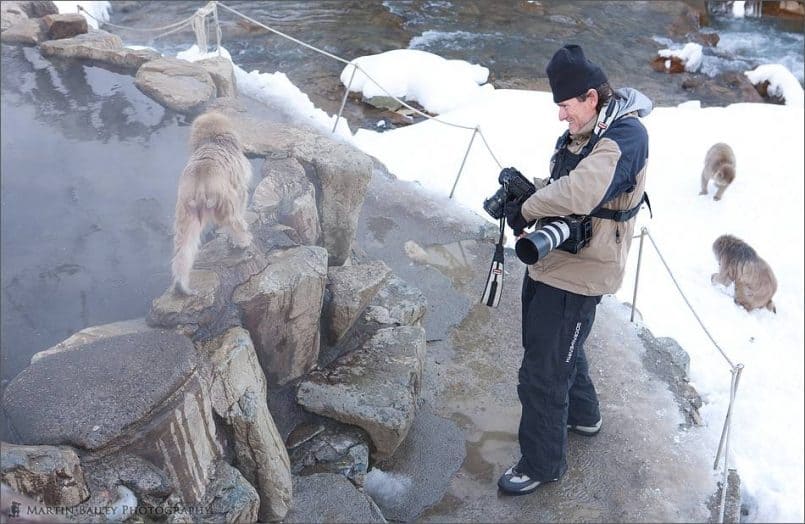

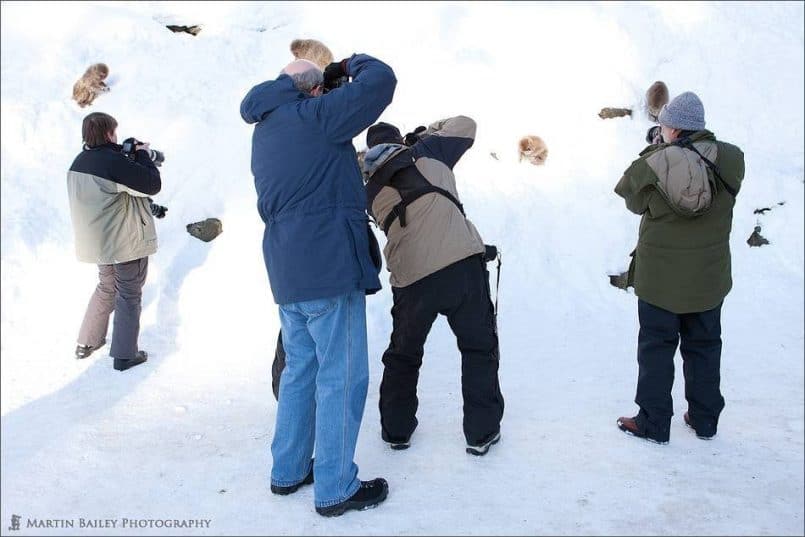
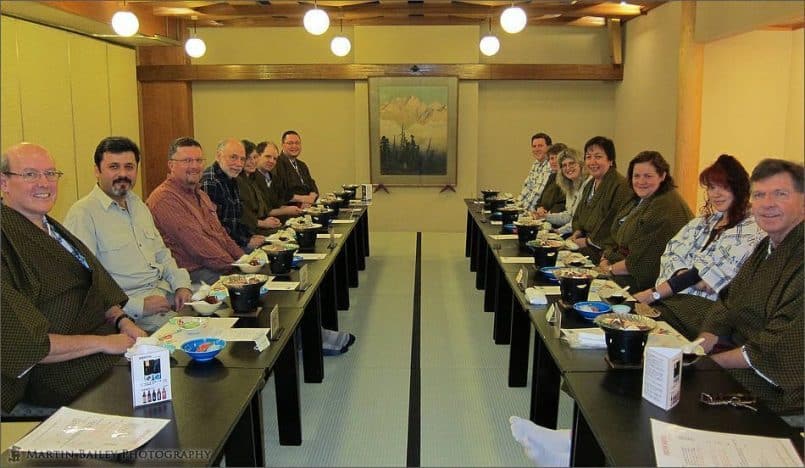
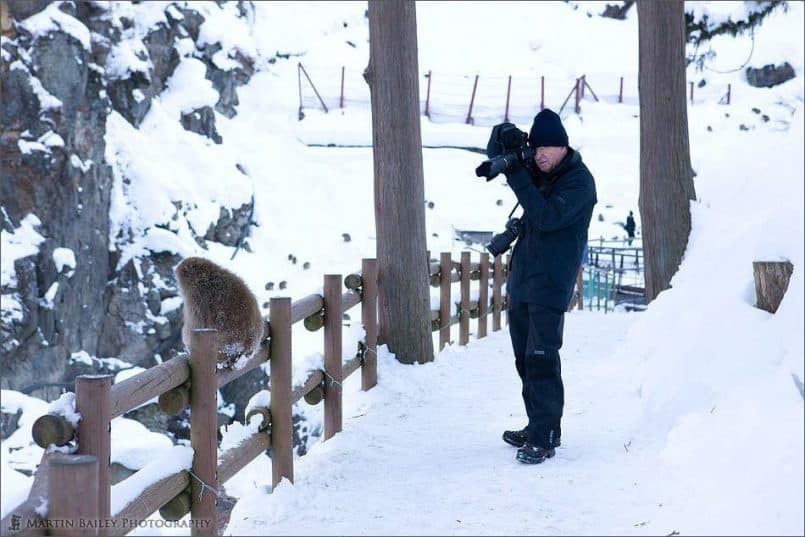
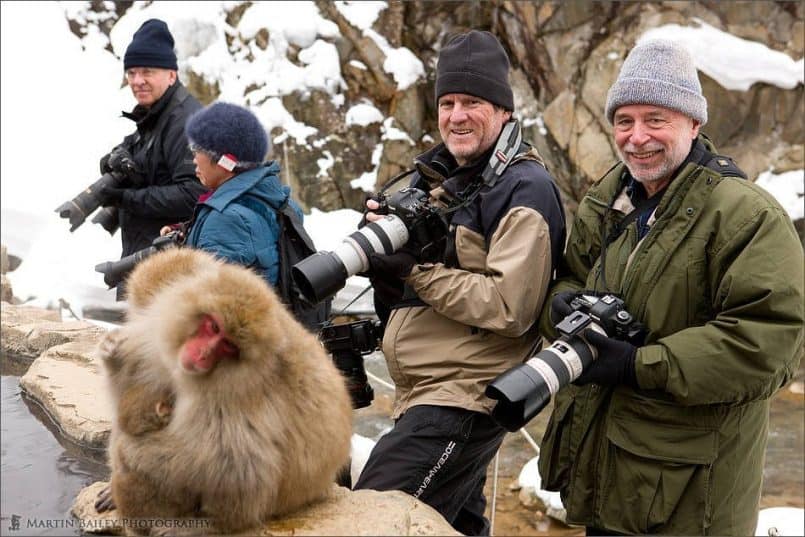
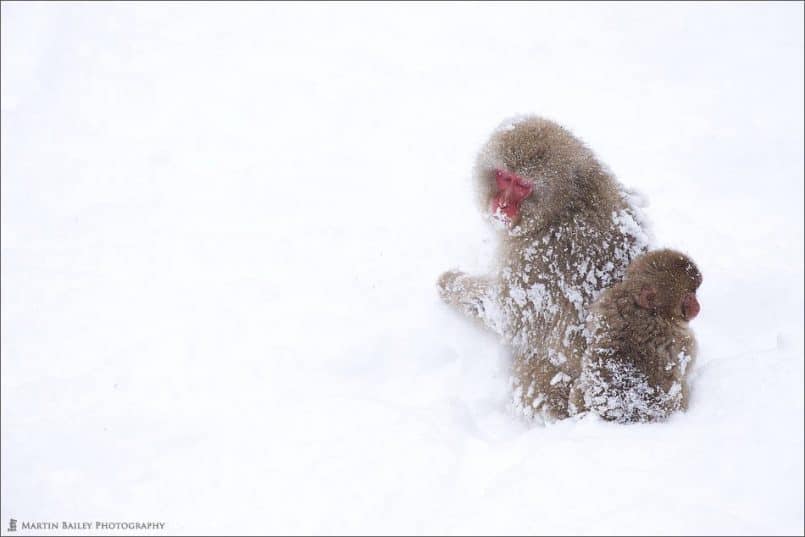
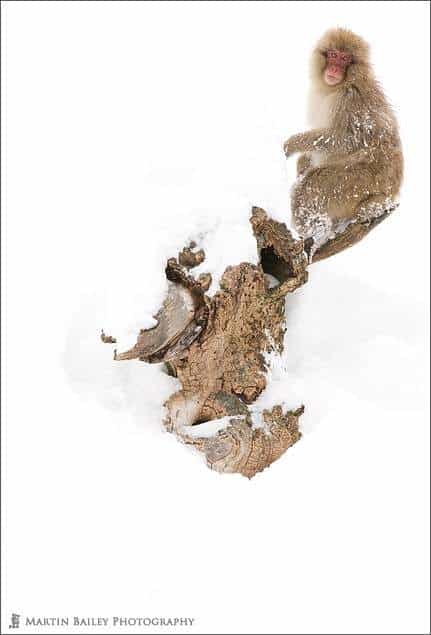
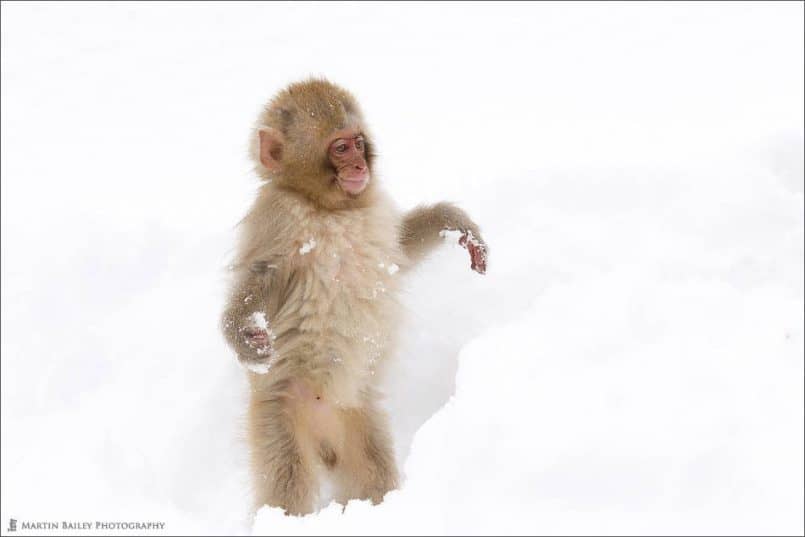


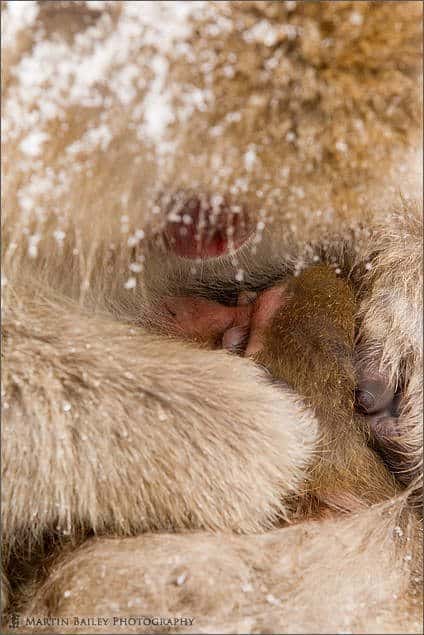

Hi, Martin,
Impressive website and great photos.
I am interested in going to shoot snow monkey this winter, few questions would like to ask you:
1. what is the better time to visit if i like to have plenty of snow on the ground? Will Christmas time be too early to see enough snow?
2. Is 300mm lens enough for the shoot? or what would you recommend?
Thank you so much in advance
Alan
Hi Alan,
Thanks for the kind words.
1. Christmas may be too early, but it depends. We’re having a relatively warm fall, so it’s hard to say. I take my tours there in late January and February, because we usually have more snow then.
2. 300mm is way too long for most of what you’ll do here. It’s nice to have a 300mm with you for long shots, but as you can see from the photos above, you are literally right next to the monkeys. I usually shoot with an 85mm and 70-200mm most of the time.
Cheers,
Martin.